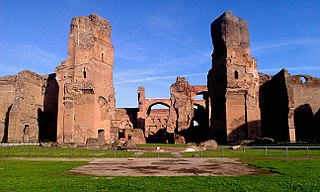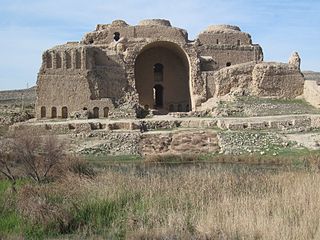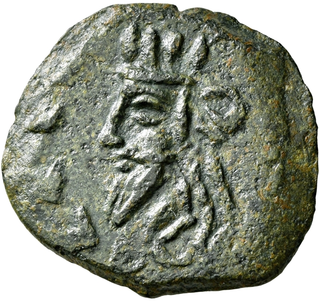This article needs additional citations for verification .(December 2009) |
This article needs additional citations for verification .(December 2009) |


The 3rd century was the period from AD 201 to AD 300 (CCC) in accordance with the Julian calendar.
The 210s decade ran from January 1, 210, to December 31, 219.
The 220s decade ran from January 1, 220, to December 31, 229.

Year 242 (CCXLII) was a common year starting on Saturday of the Julian calendar. At the time, it was known as the Year of the Consulship of Gratus and Lepidus. The denomination 242 for this year has been used since the early medieval period, when the Anno Domini calendar era became the prevalent method in Europe for naming years.

Ctesiphon was an ancient Iranian city, located on the eastern bank of the Tigris, and about 35 kilometres (22 mi) southeast of present-day Baghdad. Ctesiphon served as a royal capital of the Iranian empire in the Parthian and Sasanian eras for over eight hundred years. Ctesiphon was capital of the Sasanian Empire from 226–637 until the Muslim conquest of Persia in 651 AD.

Year 211 (CCXI) was a common year starting on Tuesday of the Julian calendar. At the time, in the Roman Empire it was known as the Year of the Consulship of Terentius and Bassus. The denomination 211 for this year has been used since the early medieval period, when the Anno Domini calendar era became the prevalent method in Europe for naming years.

Year 216 (CCXVI) was a leap year starting on Monday of the Julian calendar. At the time, it was known as the Year of the Consulship of Sabinus and Anullinus. The denomination 216 for this year has been used since the early medieval period, when the Anno Domini calendar era became the prevalent method in Europe for naming years.

The Baths of Caracalla in Rome, Italy, were the city's second largest Roman public baths, or thermae, after the Baths of Diocletian. The baths were likely built between AD 212 and 216/217, during the reigns of emperors Septimius Severus and Caracalla. They were in operation until the 530s and then fell into disuse and ruin.

Ardashir I, also known as Ardashir the Unifier, was the founder of the Persian Sasanian Empire. He was also Ardashir V of the Kings of Persis, until he founded the new empire. After defeating the last Parthian shahanshah Artabanus IV on the Hormozdgan plain in 224, he overthrew the Arsacid dynasty and established the Sasanian dynasty. Afterwards, Ardashir called himself "shahanshah" and began conquering the land that he called Iran.
Qal'eh Dokhtar, Ghale Dokhtar, Dokhtar Castle or Dezh Dokhtar is a castle made by Ardashir I, in present-day Fars, Iran, in 209 AD. It is located on a mountain slope near the Firouzabad-Kavar road.

Firuzabad is a city in the Central District of Firuzabad County, Fars province, Iran, serving as both capital of the district and of the county. Firuzabad is south of Shiraz. The city is surrounded by a mud wall and ditch.

The Palaceof Ardashir Pāpakan, also known as the Atash-kadeh آتشکده, is a castle located on the slopes of the mountain on which Dezh Dokhtar is situated. Built in AD 224 by King Ardashir I of the Sassanian Empire, it is located two kilometers north of the ancient city of Gor, i.e. the old city of Artakhsher Khwarah/Khor Adashir/Gor Adesheer in Pars, in ancient Persia (Iran). The ancient city where the palace is located, was renamed "Peroz" after Ardashir established the Sassanian Empire by overthrowing Ardavan, the last Parthian king. After the Arabian conquest, Peroz was called Firuz, and the name remained. The modern city of Firuzabad is hence, of important significance in Persian history.

Artabanus IV, also known as Ardavan IV (Parthian:𐭓𐭕𐭐𐭍), incorrectly known in older scholarship as Artabanus V, was the last ruler of the Parthian Empire from c. 213 to 224. He was the younger son of Vologases V, who died in 208.

Vologases VI was the uncontested king of the Parthian Empire from 208 to 213, but afterwards fell into a dynastic struggle with his brother Artabanus IV, who by 216 was in control of most of the empire, even being acknowledged as the supreme ruler by the Roman Empire. Vologases VI continued to rule Seleucia until 221/2, and coin mints of him even appear in Mesopotamia until 228, when he was presumably defeated by the Sasanian Empire, who had previously defeated Artabanus IV and now succeeded the Parthians as the kings of Iran.

The Sasanian Empire or Sassanid Empire, sometimes referred to Second Persian Empire or Neo-Persian Empire, officially known as Eranshahr, was the last Iranian empire before the early Muslim conquests of the 7th to 8th centuries. Named after the House of Sasan, it endured for over four centuries, from 224 to 651, making it the second longest-lived Persian imperial dynasty after the Arsacids of the Parthian Empire.
The Parthian style is a style of historical Iranian architecture defined by Mohammad Karim Pirnia.
The Battle of Nisibis was fought in the summer of 217 between the armies of the Roman Empire under the newly ascended emperor Macrinus and the Parthian army of King Artabanus IV. It lasted for three days, and ended with a bloody Parthian victory, with both sides suffering large casualties. As a result of the battle, Macrinus was forced to seek peace, paying the Parthians a huge sum and abandoning the invasion of Mesopotamia that Caracalla had begun a year before.

The Sassanid Palace of Sarvestan is a Sassanid-era building in the Iranian city of Sarvestan, some 90 km southeast from the city of Shiraz. The palace was built in the 5th century AD, and was either a gubernatorial residence or a Zoroastrian fire temple.

Tiridates II, flourished second half of the 2nd century - died 252), known in Armenian sources as Khosrov, was an Arsacid Prince who served as a Roman Client King of Armenia. Tiridates II was the son and heir of the Armenian King Khosrov I.

Sasanian art, or Sassanid art, was produced under the Sasanian Empire which ruled from the 3rd to 7th centuries AD, before the Muslim conquest of Persia was completed around 651. In 224 AD, the last Parthian king was defeated by Ardashir I. The resulting Sasanian dynasty would last for four hundred years, ruling modern Iran, Iraq, and much territory to the east and north of modern Iran. At times the Levant, much of Anatolia and parts of Egypt and Arabia were under its control. It began a new era in Iran and Mesopotamia, which in many ways was built on Achaemenid traditions, including the art of the period. Nevertheless, there were also other influences on art of the period that came from as far as China and the Mediterranean.